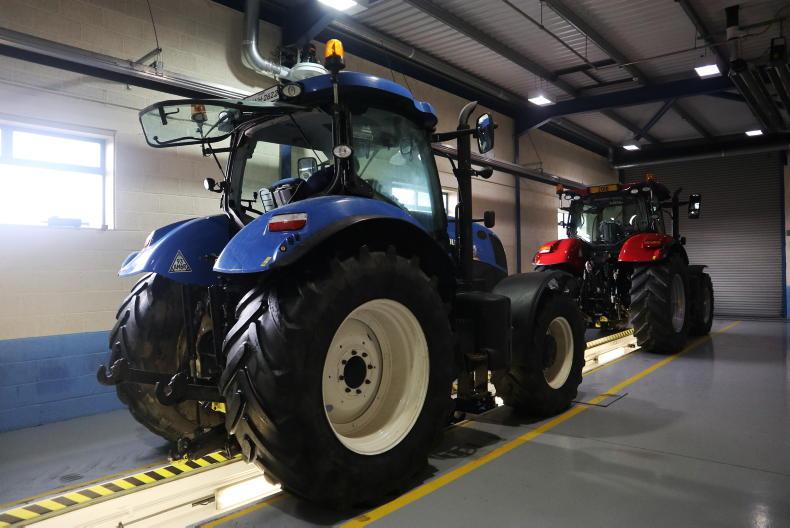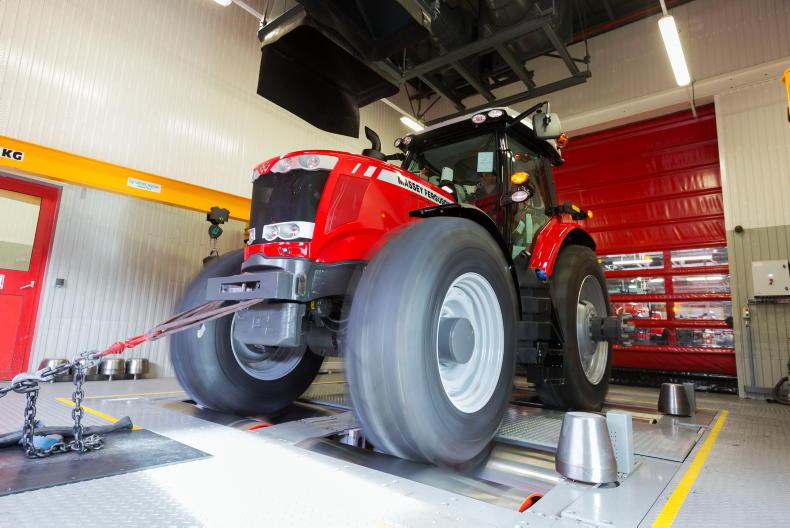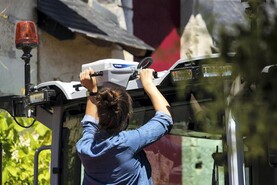A total of 333 ‘full’ RSA tractor tests have been carried out since testing first began in June 2018, the Irish Farmers Journal can exclusively reveal.
The pass rate has been improving year on year. In 2022, it hit 63%, its highest annual rate to date. Over the test’s five-year existence, the pass rate is 51.8%.
The legislation requiring fast tractors to undergo a roadworthiness test, similar to that of an NCT for cars, was introduced in May 2018. Eligible tractors are required to display a certificate of roadworthiness (CRW) on the windscreen.
The tractor test mirrors the commercial vehicle roadworthiness testing (CVRT) carried out on heavy commercial vehicles (HCVs), but has been modified to suit tractors. Eligible tractors are required to be tested after they have reached their fourth birthday, and every second year after that. Typically, each tractor test takes around one hour. Once a tractor has passed the test, a CVRT certificate will be issued to the owner. As with any CVRT, DOE or NCT, the reading on the hour meter is recorded at the time of the test.
The law states that if a tractor is deemed to have failed dangerously, it cannot be driven out of the test centre. Similar to other vehicle tests, if the initial test is failed the retest must be carried out within 21 days.
A total of 15 different brands of tractors have been tested to date. JCB is the most popular brand tested. Its renowned high-speed transport tractors accounts for one in four (25.7%) of all units tested to date.
John Deere is second at 20.2%, while New Holland has accounted for a further 16.1% of all tests. This means the three brands combined have accounted for 62% of all tests carried out to date.
Where are
tractors tested?
There are 43 RSA test centres across 21 counties in the country, all of which are also HCV testing centres. Testing to date has taken place across 20 counties. The only county with a test centre but with no test recorded to date is Dublin.
It’s the Kingdom leading the way in terms of the number of tests carried out to date, accounting for 13.2% of all tests. This is followed by Mayo (11.1%) and Offaly (9.9%), meaning three counties combined accounted for over 34% of all tests.
Meanwhile, the top 10 counties listed have accounted for almost 83.5% of all tests carried out to date.
What are tractors failing on?
Over the course of the past five years of testing, steering linkage condition and the lack of speed discs have come out in the top five reasons for test failure each year. Meanwhile, lights condition and operation, mechanical coupling and towing device and the transmission have also been among the most common failure items year on year.
Steering linkage condition is a broad term which covers a lot of moving parts. These include the rack and pinion, steering box, the orbital box, the idler assembly and track rod ends/steering arm. The presence and condition of a speed disc is inspected. If the speed disc is absent, the wrong size, not displayed in km/h or other various issues it will result in a failure.

The requirement of a fast tractor to be tested is based on its use.
Any lights not working, incorrectly positioned, not fitted symmetrically or with badly cracked lens will result in a failure. A headlamp aim tester (HAT) also tests the alignment of the dipped beam.
Mechanical coupling and towing device cover a lot of wearing parts. The lift arms and hitch are inspected for wear, distortion, repairs and modifications. A test is carried out to ensure the lift arm can retain the ball, ensuring the lever and retaining clamp are functional. If the hitch is fitted with a hook-type coupling, the distance between the keeper plate and the tip of the hook must not exceed 15mm. No building up with weld is permitted.
General inspection
The test is broken down into seven stages – starting with braking equipment, then steering, on to visibility, lamps, reflectors and electrical equipment, axles, wheels, tyres and suspension, the chassis, cab and bodywork, safety restraints, locks, horn, speedometer and finally emissions/noise.
To mention a few items, the general condition of the chassis frame, cross members and the underbody is inspected for cracks in high-stress areas and for corrosion.
Any deformation, fractures, welds, corrosion or modifications will lead to a failure. Likewise, an insecurely mounted exhaust or a damaged/leaking exhaust system will result in a failure.
Braking, the handbrake and the tractors trailer brake connections are inspected. The seatbelt and buckle must be in working order.
A horn must be fitted and working, while the speedometer must be visible from the driver’s seat, be illuminated and working.
We understand tyre fails have related to the condition (cuts, bulges, cracks, etc) of a tyre rather than the tread depth. A tyre that has a cut greater than 25mm in length or 10% of section width, will be failed. Likewise, any inappropriate tyre repairs will result in a failure.
The minimum tread depth required to pass a test is 1.6mm around the entire circumference of the tyre. However, the specification of a tyre also plays a huge factor. A tractor needs to be fitted with tyres that match its maximum speed rating.
What is a ‘fast tractor’ and what tractors need to be tested?
The Road Safety Authority (RSA) states that a fast tractor is defined as a wheeled tractor in category T, with a maximum design speed exceeding 40 km/h. The requirement of a fast tractor to be tested is based on its use. Any fast tractor which is used for a non-exempted activity (that is non-agricultural work) requires a CRW.
Such examples of tractors required to be tested include: those involved in local authority work, the construction industry, the quarrying industry, the manufacturing industry, the mining industry or road construction/roadworks.
The RSA has stated that a fast tractor will not have to be tested if it is being used for the purposes of agricultural, horticultural, forestry, farming or fishery activity solely within the State and mainly on the land where such activity takes place, including agricultural roads, forestry roads or agricultural fields.
The RSA says it is important to note that an exemption from undergoing a commercial vehicle test is not an exemption from the requirement to ensure the vehicle is in a roadworthy condition when used on a public road.
A total of 333 ‘full’ RSA tractor tests have been carried out since testing first began in June 2018, the Irish Farmers Journal can exclusively reveal.
The pass rate has been improving year on year. In 2022, it hit 63%, its highest annual rate to date. Over the test’s five-year existence, the pass rate is 51.8%.
The legislation requiring fast tractors to undergo a roadworthiness test, similar to that of an NCT for cars, was introduced in May 2018. Eligible tractors are required to display a certificate of roadworthiness (CRW) on the windscreen.
The tractor test mirrors the commercial vehicle roadworthiness testing (CVRT) carried out on heavy commercial vehicles (HCVs), but has been modified to suit tractors. Eligible tractors are required to be tested after they have reached their fourth birthday, and every second year after that. Typically, each tractor test takes around one hour. Once a tractor has passed the test, a CVRT certificate will be issued to the owner. As with any CVRT, DOE or NCT, the reading on the hour meter is recorded at the time of the test.
The law states that if a tractor is deemed to have failed dangerously, it cannot be driven out of the test centre. Similar to other vehicle tests, if the initial test is failed the retest must be carried out within 21 days.
A total of 15 different brands of tractors have been tested to date. JCB is the most popular brand tested. Its renowned high-speed transport tractors accounts for one in four (25.7%) of all units tested to date.
John Deere is second at 20.2%, while New Holland has accounted for a further 16.1% of all tests. This means the three brands combined have accounted for 62% of all tests carried out to date.
Where are
tractors tested?
There are 43 RSA test centres across 21 counties in the country, all of which are also HCV testing centres. Testing to date has taken place across 20 counties. The only county with a test centre but with no test recorded to date is Dublin.
It’s the Kingdom leading the way in terms of the number of tests carried out to date, accounting for 13.2% of all tests. This is followed by Mayo (11.1%) and Offaly (9.9%), meaning three counties combined accounted for over 34% of all tests.
Meanwhile, the top 10 counties listed have accounted for almost 83.5% of all tests carried out to date.
What are tractors failing on?
Over the course of the past five years of testing, steering linkage condition and the lack of speed discs have come out in the top five reasons for test failure each year. Meanwhile, lights condition and operation, mechanical coupling and towing device and the transmission have also been among the most common failure items year on year.
Steering linkage condition is a broad term which covers a lot of moving parts. These include the rack and pinion, steering box, the orbital box, the idler assembly and track rod ends/steering arm. The presence and condition of a speed disc is inspected. If the speed disc is absent, the wrong size, not displayed in km/h or other various issues it will result in a failure.

The requirement of a fast tractor to be tested is based on its use.
Any lights not working, incorrectly positioned, not fitted symmetrically or with badly cracked lens will result in a failure. A headlamp aim tester (HAT) also tests the alignment of the dipped beam.
Mechanical coupling and towing device cover a lot of wearing parts. The lift arms and hitch are inspected for wear, distortion, repairs and modifications. A test is carried out to ensure the lift arm can retain the ball, ensuring the lever and retaining clamp are functional. If the hitch is fitted with a hook-type coupling, the distance between the keeper plate and the tip of the hook must not exceed 15mm. No building up with weld is permitted.
General inspection
The test is broken down into seven stages – starting with braking equipment, then steering, on to visibility, lamps, reflectors and electrical equipment, axles, wheels, tyres and suspension, the chassis, cab and bodywork, safety restraints, locks, horn, speedometer and finally emissions/noise.
To mention a few items, the general condition of the chassis frame, cross members and the underbody is inspected for cracks in high-stress areas and for corrosion.
Any deformation, fractures, welds, corrosion or modifications will lead to a failure. Likewise, an insecurely mounted exhaust or a damaged/leaking exhaust system will result in a failure.
Braking, the handbrake and the tractors trailer brake connections are inspected. The seatbelt and buckle must be in working order.
A horn must be fitted and working, while the speedometer must be visible from the driver’s seat, be illuminated and working.
We understand tyre fails have related to the condition (cuts, bulges, cracks, etc) of a tyre rather than the tread depth. A tyre that has a cut greater than 25mm in length or 10% of section width, will be failed. Likewise, any inappropriate tyre repairs will result in a failure.
The minimum tread depth required to pass a test is 1.6mm around the entire circumference of the tyre. However, the specification of a tyre also plays a huge factor. A tractor needs to be fitted with tyres that match its maximum speed rating.
What is a ‘fast tractor’ and what tractors need to be tested?
The Road Safety Authority (RSA) states that a fast tractor is defined as a wheeled tractor in category T, with a maximum design speed exceeding 40 km/h. The requirement of a fast tractor to be tested is based on its use. Any fast tractor which is used for a non-exempted activity (that is non-agricultural work) requires a CRW.
Such examples of tractors required to be tested include: those involved in local authority work, the construction industry, the quarrying industry, the manufacturing industry, the mining industry or road construction/roadworks.
The RSA has stated that a fast tractor will not have to be tested if it is being used for the purposes of agricultural, horticultural, forestry, farming or fishery activity solely within the State and mainly on the land where such activity takes place, including agricultural roads, forestry roads or agricultural fields.
The RSA says it is important to note that an exemption from undergoing a commercial vehicle test is not an exemption from the requirement to ensure the vehicle is in a roadworthy condition when used on a public road.







 This is a subscriber-only article
This is a subscriber-only article










SHARING OPTIONS: